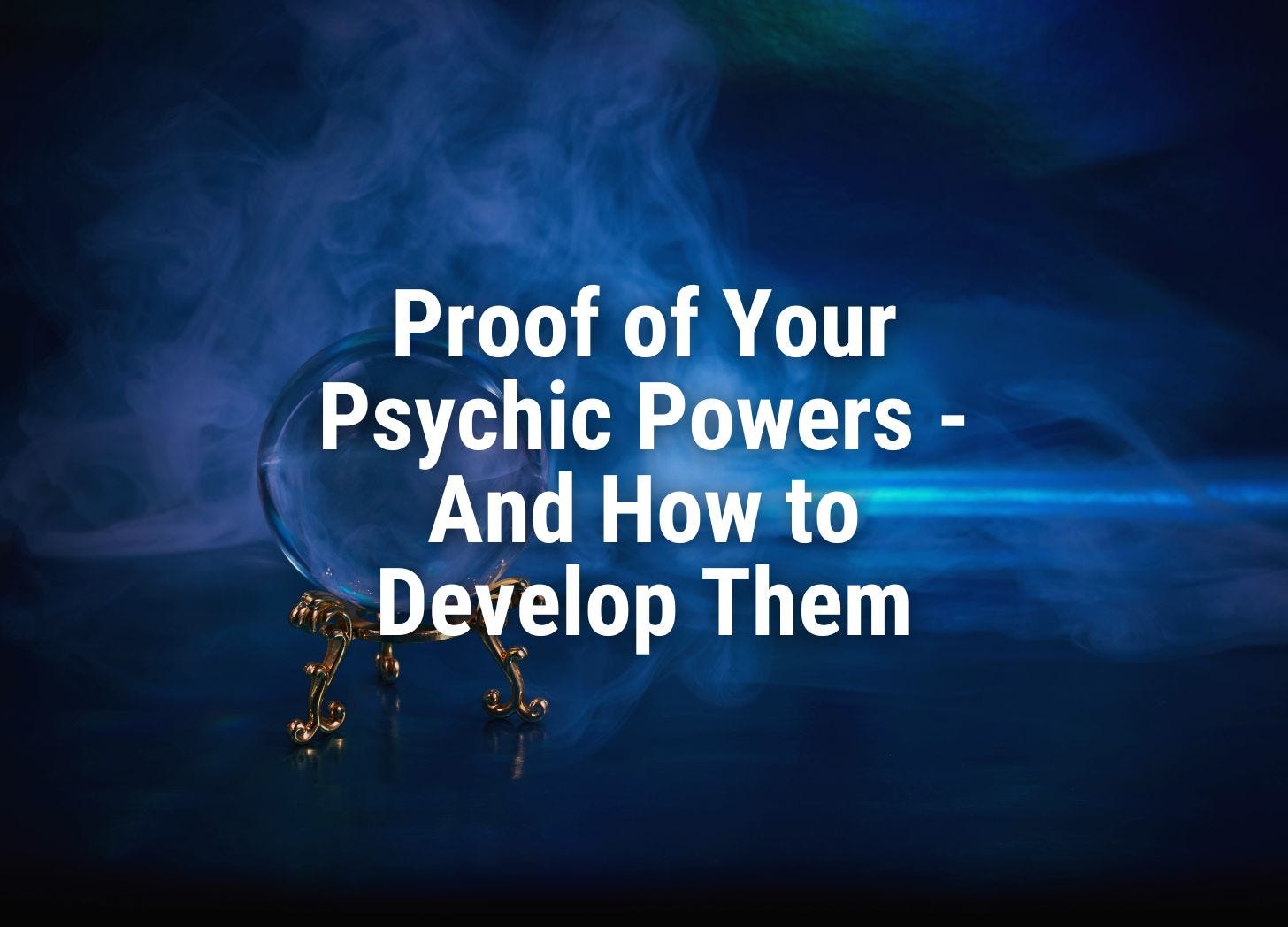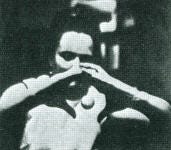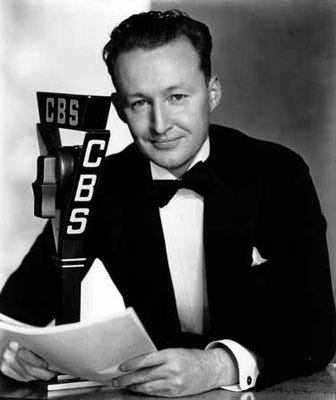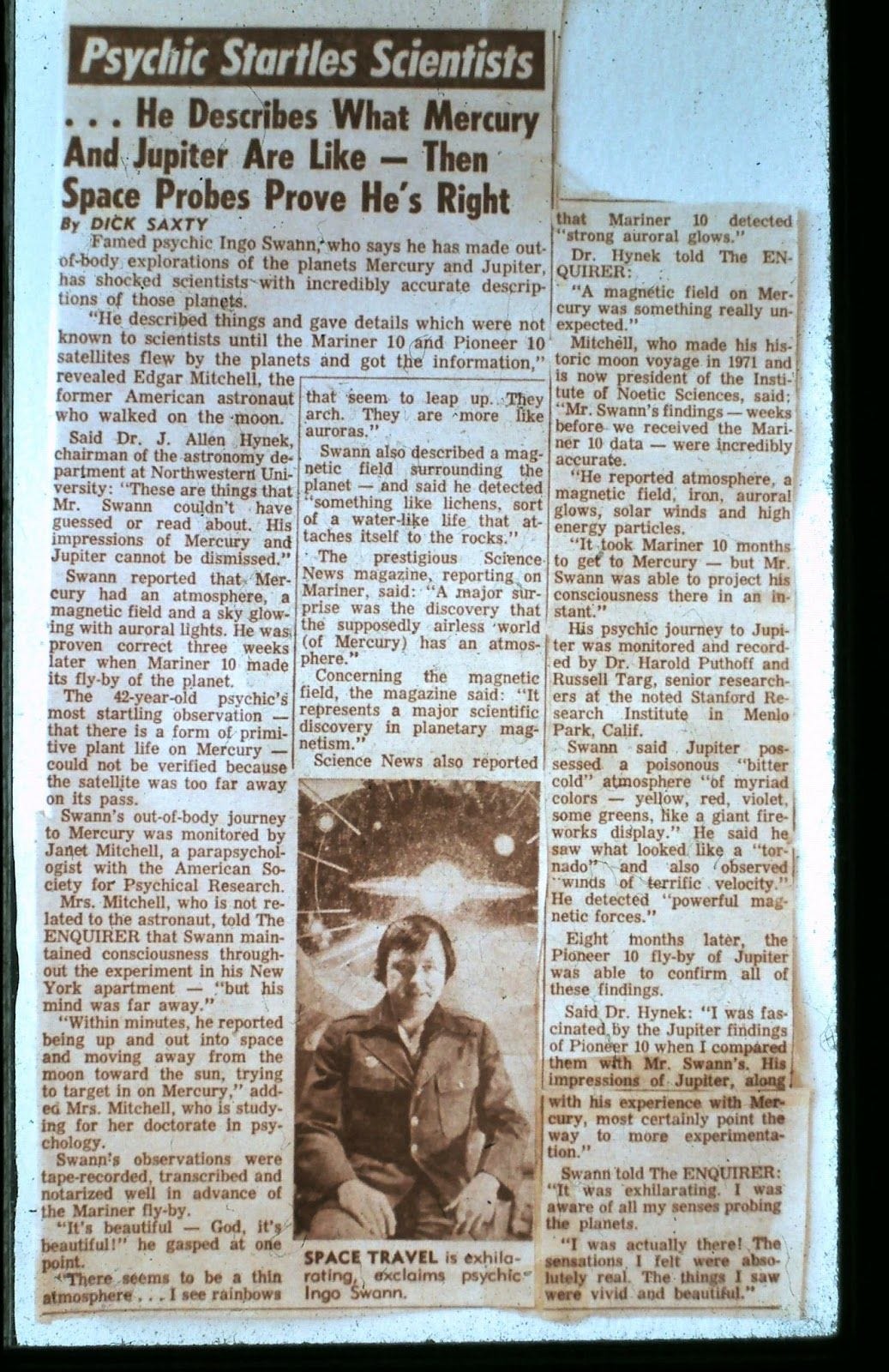Truthiverse produces an audience-supported publication with a powerful podcast, regular consciousness-expanding spiritual content, and well-researched pieces on mind-expanding, obscure, and even taboo-but-crucial topics.
If you find value in my work, please join the growing community of subscribers. ⤵️
Hit that ‘Subscribe’ button!
Share with fellow seekers 🙏
Consider becoming a paid subscriber to support the building of new paradigms and a free world (based on truth)!
👁 FREE masterclass: Check out ‘How to Evolve Yourself Without Hard Work or Meditation’
This is what I do full-time. Thanks in advance for your support - it means a lot! 👊🏼
Repeated ignorant or stubborn denial of the existence of certain powers does not keep them from existing—except for us!—Harold M. Sherman, psychic
Preamble
Everyone has some level of innate intuitive ability / psychic powers.
This has been demonstrated repeatedly over several decades of experiments by the parapsychological community – through tens of thousands of trials utilizing thousands of regular people with no known or presupposed psychic gifts.
(And that is to say nothing of the many successful experiments carried out with people with well established reputations for performing “paranormal” feats.)
While some people are born with obvious psychic talents, most of us have to invest time and effort over the long-term in order to develop them from their latent state.
In this article we will look at some of the dynamics of psi ability at play, as well as some guidelines and relevant principles for unblocking and developing your innate psychic powers.
Open Your Mind and Eliminate Closed Ones
Have you ever noticed how closed-minded skeptics (CMS) rarely have any experiences with the siddhis (psychic faculties) or the “paranormal” in general?
Soviet research into psychokinesis involving Nina Kulagina demonstrated qualitatively that a skeptic’s mere presence does have an effect on a psychic’s ability to function properly. Hence, with a CMS (or several) in the room or otherwise involved in the experiment, a psychic is more likely to “fail,” thus “proving” the CMS right (at least in his own narrow reality tunnel).
It is merely a case of self-fulfilling prophecy.
Thus, regarding your own psi abilities, what you believe is true, to a large extent—and unfortunately the presence of non-believers nearby or within the experimental setup can be detrimental.
Dr. Valerie Hunt’s research in Infinite Mind showed a correlation between electromagnetic auric frequencies and the “level” of consciousness occupied by the individual. Healers, mediums and mystics showed higher frequencies in their electromagnetic fields than others not of those categories, illustrating that those possessed of “higher” consciousness are, in some sense, literally “on a higher frequency.”
Those fixated on or believing solely in “material reality” exhibited lower dominant frequencies and were bereft of the higher.
In fact, gamma frequencies in the brain of 40-100 Hertz—the highest of the better known bands of brainwave frequencies (the higher band being Lambda, reaching up to about 200 Hz )—have been linked to the ability to manifest intention in the world. Gamma states represent the brain in hyperdrive, working at its most intensely.
“This oscillation is conducive to creating links across many parts of the brain,” facilitating an integrated whole-brain state. Paradoxically, the extreme high and low ends of the brainwave spectrum have the same states of consciousness associated with them, and different oscillations can be present at once in different parts of the same brain.
To illustrate, Russian psychokinetic (PK) psi star Nina Kulagina (1926–1990), under controlled experimental conditions, could (among other things) separate an egg yoke from the white from a distance of 6 feet while it floated in a saline solution using only her intention.
At the time, she showed low frequency theta brainwaves of 4 Hz—normally associated with a deeply relaxed trance—whilst simultaneously showing extreme physiological agitation, including a pulse rate of 240 bpm.
These strenuous efforts left her absolutely exhausted, and temporarily blind on that particular occasion.
Perhaps all of the above explains why Kulagina’s PK abilities “worked better in an atmosphere of friendly mutual trust and belief”—PK, as we know, generally requires intense states of physiological arousal and higher frequency brainwave activity, all of which drains large reserves of bioenergy.
PK is a higher brain function. Kulagina experienced less stress when working alone and it was said that her PK ability was mood-dependent (both her own mood and that of the observers) and expended more energy in a hostile or skeptical atmosphere (where the local consciousness fields would have been less coherent or conducive).
Hostile skeptics have something of an innate psi- or consciousness-damping effect; they literally operate at a lower frequency, their mind-fields interfering with those of the test subject (and even the target). The fact that separate minds interact via measurable electromagnetic fields (and some not-so-measurable fields) has been proven by Hunt and others, and I detail much of this research in The Grand Illusion – Book 1 (TGI 1).
Negativity causes chaos and/or entropy in the personal and local ambient energy fields. In contrast, positivity, gratitude, or love—heart-based emotions—cause coherence, beauty and order—just look at the instances of saints and yogis whose dead bodies have remained impervious to decay for weeks, months, and even years!
This is worth considering before any psi endeavour where you intend to act as a receiver of information. Firstly, open-mindedness is a bare minimum requirement (confidence and trust in the process is even better). Additionally, being in a state of peaceful heart-based coherence is likely to enhance receptive abilities.
In combination with deliberate intention, this has been shown to also be enough to wind and unwind DNA samples at will in laboratory conditions, with powerful implications for self-healing possibilities.
But check this out.
In 1942 psychologist and parapsychologist Gertrude Schmeidler initiated her infamous “sheep-goat” experiments, designed to test whether belief and open-mindedness would enhance psi function in contrast to skepticism.
Two groups, “sheep” who believed in or were simply open to psi, and “goats” who did not believe it could happen for them under test conditions (but were not hostile to the possibility of it happening to or for other people), were put through identical standard controlled ESP tests.
The outcome indicated that believers in the possibility of ESP scored better than those who did not: the disbelievers scored lower, ergo belief is a legitimate variable mediating psi functions.
“A meta-analysis by [psychologist Tony Lawrence], covering 73 experiments by 37 different researchers, clearly confirms that subjects who believe in psi obtain, on the average, higher results than those who do not believe in it.”
American psychic and author Harold Sherman (1898–1987) had noted in the early 1940s that while it is possible to receive thought impressions from a skeptic, it is extremely difficult for someone of that mindset to act as receiver. Sherman, who was ahead of his time, explained that telling yourself with certitude that there is no such thing as psi is tantamount to instructing your subconscious mind to shut down your psychic powers so they do not operate for you.
In a dream-like reality such as ours, it pays to be open-minded—especially if you want to be more intuitive.
Meaning, Emotion, Need, Novelty, and Other Factors in Psi
Need, novelty, and emotion have long been known to play a part in psi phenomena.
Carl Jung (1875–1961)—the originator of the theory of the psychological archetypes—noted with interest that the English medium Eileen Garrett fared poorly in parapsychologist J.B. Rhine’s card-guessing experiments because she was unable to conjure any feelings for Rhine’s “soulless” test-cards.
Much experimentation has also shown that psi effects have a tendency to start out higher in the initial stages of testing and then drop off as the participants lose interest and boredom sets in (the “decline effect”).
Charles Tart actually went so far as stating that card-guessing experiments are, ironically, “a technique for extinguishing [psi] in the laboratory,” that is, they bore the subjects into a decline effect.
Rhetorically, Sherman asked how he could possibly be expected to get excited over five abstract symbols that had nothing to do with his emotional system or that of the sender (they lacked meaning/personal significance or relevance).
Biologist and author Lyall Watson notes in Supernature that the most effective telepathic messages generally are bound up in trauma and crisis—and we see plenty of evidence to that effect in the literature. He continues to explain that it makes sense biologically, since states of well-being and pleasure produce no sense of urgency—such information can be leisurely conveyed by the “normal” channels.
However, for alarm signals to be of real use, they have to travel the fastest way possible.
That “way” is superluminally/nonlocally.
Much as Cleve Backster’s plants could detect the death of bacteria and brine shrimp nearby, our human telepathic connections must—even if only subliminally—serve a biological imperative, helping us survive and propagate as a species by sensing and avoiding danger.
The limbic system, which includes the amygdala and hippocampus, is considered today to be the emotional center in the brain, as well as the seat of our survival instinct. We might speculate that life-threatening events, usually being highly emotionally charged, might ignite the temporal lobe and related structures in the brain into downloading nonlocal psi information from the vacuum/aether.
Dr. Melvin Morse believes humans have a sixth sensory ability located “within” the right temporal lobe, hippocampus, and related limbic structures. According to him, this region “interprets information obtained through communication with an interactive universe,” and allows for telepathic communication with other people through their right temporal lobes.
“It involves perception of other realities.” He states that we perceive the operation of the right temporal lobe as “intuition.”
In 1889 a committee of psychical researchers began a five-year project of compiling what they named a Report on the Census of Hallucinations—the first major research effort of the English SPR, featuring 410 data collectors. The committee included Henry and Eleanor Sidgwick, Alice Johnson, archskeptic Frank Podmore, and the esteemed Frederick Myers.
Out of the 17,000 responses, 2,273 people reported having had “hallucinations” (psi experiences). Tellingly, most occurred in a crisis, usually a death crisis, signifying the importance of emotion, need, and above all, meaning in paranormal events.
These were some of the earliest scientific results illustrating nonlocal correlations between well-acquainted (meaningfully connected) people.
Aside from raw emotion, biological threats to loved ones (or oneself), and so on, another factor conducive to psi is simply novelty.
Russel Targ and Harold Puthoff in their scientific remote viewing research in the 1970s found that the more difficult and challenging a remote viewing task they devised for test subjects, the more likely the results were to be good. They too observed a need-serving theme in their RV research at Stanford (see Chapter 12 of The Grand Illusion – Book 1).
As a result of consistently challenging and interesting tests and protocols (with the added benefits of feedback and encouragement), they found that their subjects actually improved their psi performance over time, in contrast to Rhine’s and others’ results with card-guessing and other repetitious and dull forms of testing, where decline effects were often observed.
In Sherman’s view, the absence of a strong or even an ordinary emotional factor is the greatest handicap in any psychic endeavour. Since his pioneering long-distance telepathy experiment with Sir Hubert Wilkins decades ago, much data has accumulated indicating that there is a great deal of truth in this. The stronger the emotional charge, the greater the likelihood that psi data will penetrate from the “subconscious” to the conscious mind.
It is well known by occultists that emotionally charged events are more likely to impress themselves, inadvertently or otherwise, on the mind of another than are events with little emotional content. In occult terms, this interaction occurring beyond the standard space-time realm is occurring via the astral plane/octave—the home of emotion.
The more strongly the plasma-like astral body can be made to vibrate in response to emotional content, the more likely the information is to penetrate through from the subconscious to the conscious level of awareness.
When sleep is involved, the conditions seem to be even more conducive to accidental telepathic contact, as it is an altered state of consciousness (theta and delta brainwave states) that opens us up to the frequencies of the astral or even mental planes while simultaneously eliminating most data/noise from the physical senses.
Undoubtedly, much “paranormal phenomena” (including poltergeist phenomena, PK, and telepathy) can be linked to strong emotional content. There are indications that what we experience as presentiment or precognition may be, in some sense, the strong emotional content of a probable “future” event (which is actually occurring in a parallel universe in present time, along with all our “past” and “future” lives) then filtering “back” through time into our subconscious or even conscious awareness.
Hypnosis
Hypnosis can aid our ability to peer into these “future” events and timelines.
The young actress Irene Muza was in a hypnotic trance when she was asked if she could see what awaited her in her future. She wrote that her career would be short and her death would be “terrible,” though she dared not specify how she would die.
The experimenters erased what Muza had written before bringing her out of the trance so she would not see it. She therefore had no conscious knowledge of what she had written.
Some months later, however, in 1909, her prediction of a short career and terrible death was unexpectedly fulfilled when her hairdresser allowed some drops of an antiseptic lotion made of mineral essences to fall on a lighted stove, instantly enveloping Muza in flames. Her hair and clothing set alight, she was severely burned and tragically died in hospital a few hours later.
Hypnosis has been successfully employed for psychokinetic purposes as well. Take American Ted Serios, the “thoughtographer” born in 1918 who could create colour pictures on unexposed film simply through sheer intention while he stared into the lens of a Polaroid camera.
His talent grew out of a DIY hypnosis experiment with a friend (a fellow bellhop at the Chicago Conrad Hilton Hotel) who instructed Serios under hypnosis that he could take photos of the contents of his mind. And thereafter, so he could—somewhat erratically, mind you. (Serios was tested extensively under controlled conditions.)
Interestingly, Serios had to work himself virtually into a state of rage to be effective during these experiments.
Notably, Israeli “paranormalist” Uri Geller has been able to achieve similar feats, taking photos of himself on high-speed black and white film through a solid black lens cap (See The Grand Illusion - Book 1 for research into Geller).
Dr. Chris Humphrey explains this is due to quantum tunneling: if the quantum de Broglie probability wave exists on both sides of a barrier, then its particle (photons in this case) can sometimes be on one side, and sometimes on the other, without ever passing through the barrier.
Conscious intent influences the probability of the quantum wave “collapsing” on the chosen side of the barrier.
PK: Set Your Intent, Let Go, and “Let God”
During his first stay at the Stanford Research Institute (SRI – now Stanford Research Institute International), ex-Psi Spy Ingo Swann worked on experiments with physicist Hal Puthoff, who was making forays into researching psi ability / psychic powers. This example demonstrates that we can and do interact with matter via our minds, whether we intend to consciously or not (and even under pressure and in the presence of skeptics in this case).
On the evening of the 6th of June 1972, Swann was asked to try to influence a magnetometer located in the basement which he was duly escorted down to—with one catch: the magnetometer—inside a quark detector, in actual fact—was buried under five feet of concrete underneath his feet, and thus invisible to him.
What was visible to the extremely chagrined Swann (who was not forewarned by Puthoff of the nature of the experiment) was a chart recorder with its pen slowly tracing out a graceful wavy line. It was “monitoring the magnetic stability of the magnetometer and had been doing so for some weeks without any change in the rhythmic fluctuations,” Swann recalls.
“The whole of this contraption was encased in an aluminum container and insulating copper canister. As well, it was in a supercooled, hence superconducting shield.”
The Josephson junction inside the detector would detect any variation of magnetic flux in the supercooled equipment and the effect would show up as a change in the steady sine wave recording on the chart which they could all see.
Swann started “probing” mentally to see if he could identify the expensive underground device, and when he sensed some “metallic differences” he tried to affect them, stating so as he went along.
With all eyes glued on the sine wave, Swann attempted several times to perturb the well shielded system, to no avail. Insisting that he could see something, Swann proposed that sketching it out might assist the process, but when no paper could be found to draw on, Puthoff suggested he draw directly onto the chart paper.
“So I sketched a this, and then a that: ‘Is this the Josephson junction?’ I asked. ‘If so, I think I can see it quite well.’”
With that comment, the ink pen gave a tiny jerk, and then stopped momentarily. Then it lifted up above its previous pattern, and “somewhat above this it wobbled along for no less than about TEN SECONDS—long enough for two wavy line intervals to have occurred.”
The point here is that when the distortion in the sine wave took place Swan was not trying to affect the equipment—he was simply trying to sketch what he could see with his mind’s eye. In those moments where his volitional mind was distracted and his goal momentarily suspended, the desired outcome occurred literally effortlessly.
In laboratory tests with PK in ordinary people (Swann was known to be a gifted psychic, though more in the realm of remote viewing than PK), effects often fail to appear until the subject has their attention diverted.
This is something that astral traveller Sylvan Muldoon wrote of some 80 years ago, explaining that charging the mind with desire or intent creates “stress” for which the mind seeks an outlet or release via a part of the subconscious he called the cryptoconscious will: “Then [it] gets a chance to work on the ‘stress,’ and that which you had given up trying to attain ‘materializes’!”
11 Tips for Developing Your Psychic Powers... (continued in The Truthiversity)
⚠️ For the FULL article AND access to ALL of my multimedia research and presentations, become a member of The Truthiversity.
About Me/Brendan:
Host of Truthiverse podcast. Author of the epic, “The Grand Illusion: A Synthesis of Science and Spirituality — Book 1.” (Book 2 is nearly finished!) Founder of The Truthiversity, the #1 consciousness-raising university 📽
As stupidly affordable as it is, if your budget’s too tight for the whole enchilada inside The Truthiversity, feel free to donate a lesser Substack subscription ⬇️ to support my work here - thanks in advance! :-)
🚨 Want to know when “The Grand Illusion - Book 2” is ready?
To get on the wait list and be notified when this groundbreaking and monumental work is available, click below ↴
📘 Grab a copy of Book 1 by clicking the pic below (my site has the lowest prices) ⤵️
📲 Follow me on Instagram and BitChute: @BrendanDMurphyOfficial
*Note: All citations and quotes in this article are provided inside The Grand Illusion - Book 1










Great piece. Love the book, too.